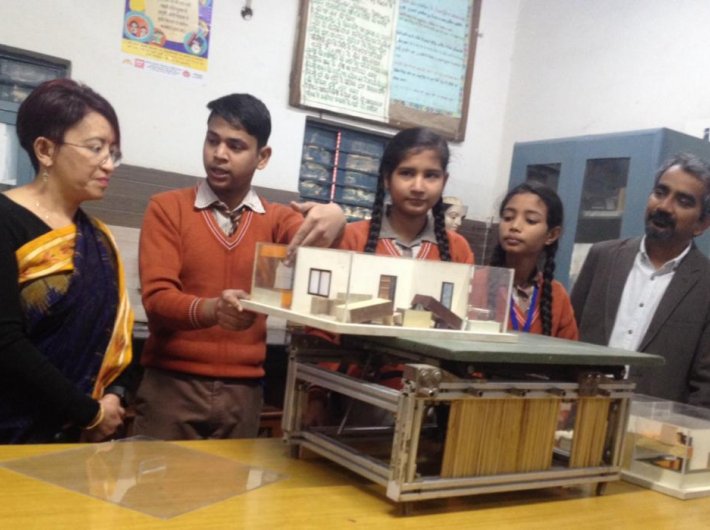An NGO and a tech major join hands to turn schools into strategic entry points for risk management
In the science laboratory of a modest government school, a team of young students give a demonstration of what is called ‘non-structural mitigation’. When earthquake-like jolts are given to a doll’s-house like building model, the beds, the dining table, cupboards, wall hanging make a mess. This is what causes most harm during a quake, a young girl points out, now taking up another model for show-and-tell comparison. The other one, in which all furniture and loose parts are clamped down to the walls and the floor, shows no change even after the girl gives a good jolt. “This is why our school has ‘L clamps’ on all blackboards and wall hangings,” she adds.
More than the disaster preparedness, it is the confidence of the children that is touching. They are, after all, from a stratum of society from whom many may not have expected such pluck. This is the government co-ed secondary education school in Khichripur, an urban village with mostly migrant population including domestic helps that serve the two upscale localities in the neighbourhood, Mayur Vihar and Indraprastha Extension.
Behavioural changes among the children – and changes in the school building – have been brought about by a campaign run by the Delhi-based environmental NGO SEEDS and supported by the Gurgaon-based tech major Honeywell India under its CSR.
In their efforts to make schools better equipped to meet any disaster, they came up with ‘Honeywell safe schools: a tailor-made, child-first, holistic approach to risk mitigation’ about two years ago. Now it is running is 51 schools in the east district of the capital, which falls in an Earthquake Zone 4. It has so far involved 52,000 children, 45,000 parents and 2,200 teachers.
While SEEDS started in the mid-90s with a vision of intervention in environmental issues in general, it came to focus on disaster mitigation after the Yamuna floods swamped the slums in riverbeds and made thousands homeless, recalls SEEDS co-founder Anshu Sharma, who studied urban planning in Delhi and did doctoral research on environment in Kyoto. Adding to it was a survey of ‘Risks in Delhi’ – the capital seats on seven fault lines and his work in Bhachau after the Gujarat 2001 quake that prompted Sharma to devote more energy to disaster risk mitigation. Over the years, SEEDS has imparted training to self-taught contractors so that the risks from ‘sub-standard’ houses in urban villages of Delhi can be mitigated.
While SEEDS is also actively involved in disaster mitigation in Kerala and elsewhere in the country, the idea of school-specific intervention materialised after the Honeywell India support. The company, on its part, had started in this direction with a fire safety programme in Pune in 2007, and expanded it to a “more comprehensive school safety programme”. “The school provides a strategic and effective entry point. Every parent is bound to be worried about the safety of their child once the child leaves home for school. When we spread awareness about disaster mitigation to school children, the message goes to their families too. They start enforcing behavioural changes at home,” says Sangita Ghalay, head – CSR, Honeywell India. Now, the same programme has been extended to 100 schools in Dehradun and Haridwar in Uttarakhand this year.
The capital has fortunately not suffered from a major earthquake in living memory, but given the fault-lines below the ground, one is bound to come up sooner or later, and the only way to reduce its harm is to be better prepared, say Sharma and Ghalay. The head of the school, Anuradha Madan and teachers agree, and add with a smile that thinking about such small measures not putting benches behind classroom doors has become part of their mind set.
Sharma draws the larger picture when he points out that there are about 15 lakh schools across the country and about 1.5 lakh of them fall in Earthquake Zone 4 and 5. “In our day-to-day lives, we go about at ease thinking that a quake is unlikely because there has been none in recent past. But the fact is that it is bound to strike somewhere at some point of time. Every parent should ask the school, the government – indeed, society at large – if their child is safe.”
The talk of the quake possibility may sound doomsday thinking to some, the programme is not limited to the quake factor alone: the students and teachers are trained in handling fire extinguishers, the school building has various signages making it a safer place, and the young children are taught hygiene.
On a wall, a chart explains in details the notion of carbon footprint, its exponents, and turns it into a game for children – and they enjoy spending time on it, calculating ways they can leave lesser wastage today or impact their environment less. Again, as Aruna Sharma, disaster management in-charge from the education department of the Delhi government, puts it, “the children’s level of confidence is immense”.
